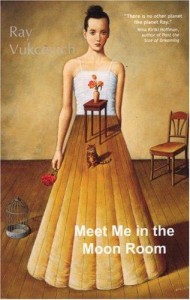 Before beginning Meet Me in the Moon Room (Small Beer, 2001; all quotations are taken from this text.), I had never read anything by Ray Vukcevich. Part of what drew me to this collection initially was that it was published by Kelly Link and Gavin Grant, so I knew it would be good; but I was also drawn to the title, the cover (in this case I was right to judge a book by its cover), and the description of Vukcevich’s work on the back cover: “Here are 33 weird, wonderful stories concerning men, women, teleportation, wind-up cats, and brown paper bags. By turns whimsical and unsettling—frequently managing to be both—these short fictions describe family relationships, bad breakups, and travel to outer space.” I should also point out that its bookstore categorization, according to the back cover, is “Fiction/Fantastic Fiction.” Vukcevich writes in the surrealist/absurdist mode, which I hoped would help me think about stylistic and narrative issues a little more liberally. Warning: Spoilers to follow.
Before beginning Meet Me in the Moon Room (Small Beer, 2001; all quotations are taken from this text.), I had never read anything by Ray Vukcevich. Part of what drew me to this collection initially was that it was published by Kelly Link and Gavin Grant, so I knew it would be good; but I was also drawn to the title, the cover (in this case I was right to judge a book by its cover), and the description of Vukcevich’s work on the back cover: “Here are 33 weird, wonderful stories concerning men, women, teleportation, wind-up cats, and brown paper bags. By turns whimsical and unsettling—frequently managing to be both—these short fictions describe family relationships, bad breakups, and travel to outer space.” I should also point out that its bookstore categorization, according to the back cover, is “Fiction/Fantastic Fiction.” Vukcevich writes in the surrealist/absurdist mode, which I hoped would help me think about stylistic and narrative issues a little more liberally. Warning: Spoilers to follow.
One question I found myself asking over and over as I read Meet Me in the Moon Room was, “What makes a short story?” For, in truth, I’m not convinced that the bulk of Vukcevich’s collection actually satisfies the traditional definition of a short story. Generally, there’s a set up, usually some rising action, but frequently no climax—or not a clear climax—and pretty much no denouement at all. During my MFA program, I had a few discussions with other students and some faculty about the difference between mainstream fiction and genre fiction. One of my classmates, Mary Pauer (in Fiction), said she thought the difference had to do with plot: mainstream fiction may take or leave plot, but genre fiction always had one, which seems as fine a distinction as one could want. So color me surprised when I started reading this collection of “Fiction/Fantastic Fiction” and realized that plot was secondary to weirdness.
Guided by the question above, let’s examine the plots of a few of Vukcevich’s stories. The first story in the collection, “By the Time We Get to Uranus,” is about people who slowly become engulfed in spacesuits and then float off into space. The engulfment is like a disease—that is, people “come down with the suit” and we’re told “there would be no cure for years” (9)—beginning at the feet and working up. The main characters are Jack and Molly, the latter of whom has the suit. Over the course of the story, she becomes engulfed in the suit, and Jack tries to tether her to keep her from floating away until his own suit is finished. She does float away, however, and Jack’s suit finishes and he hopes to catch up with her via activating a “fire extinguisher which increased his velocity considerably” (21). The story has a clear rising action (Molly’s engulfment), but I can’t pinpoint a clear climax: is it when Jack lets Molly go into space? That doesn’t seem quite to fit, at least from my point of view. The last page or so of the story is Jack’s suit finishing and his own floating away (the fire extinguisher line above is the actual last line of the story). The story doesn’t feel complete to me, although I didn’t—and don’t—find that to be a negative as a reader. But it does make me rethink this traditional story structure: how necessary is it?
“No Comet” might be a better example. The story focuses on Tim, who has convinced his wife Jane and daughter Sacha into wearing brown paper bags over their heads as a means of avoiding worldwide destruction by an oncoming comet, an absurd act supported by “Bohr’s version of the Copenhagen interpretation of quantum mechanics” (71): if you can’t see the comet coming it won’t come. Tim tells Jane, “Things that might happen can’t be separated from the devices you use to measure them… You can’t look at something without changing it” (73). The paper bags are metaphorical, as well; Tim is convinced that Jane wants a divorce, which she does, and this moment of “family bonding” might seem like a last-ditch effort to avoid the destruction of their marriage (if they don’t look at the failed state of their marriage, it won’t fail). Of course, according to this theory, Tim surmises someone somewhere did peek at the comet, but because they don’t peek, they’ve “split off into a reality in which the comet never existed in the first place” (76). The last line of the story suggests this is true: Jane says she’ll “take the cat” to which Tim replies, “What cat?” (76): a new reality. The little twist at the end, the likes of which mark most of Vukcevich’s stories, is like a punchline, but there’s no clear resolution here, and certainly no preceding climax (unless one might count the moment where Tim imagines that Jane and Sacha have actually removed their bags and Sacha sees the comet, at which moment Tim imagines the destruction of the planet). Clearly, based on the set ups here, Vukcevich isn’t writing mainstream fiction, but he does employ the techniques of a lot of contemporary mainstream writing—maybe a climax, maybe not, but no clear resolution at the end of the story (I use the Best American Short Stories anthologies in my Fiction workshop, and students are frequently stymied by the lack of resolution in so many of the stories).
Plotting is often a concern of mine, and Vukcevich’s “disabling” of plot in fantasy fiction does give me a lot to consider. I don’t think mainstream writers are taking the “easy” way out by not giving the readers resolution, and I imagine there is a lot of deliberation in crafting these unresolved endings. I wonder how my stories might fare if I didn’t struggle so much with coming up with an “appropriate” resolution, which often feels to me strained (I do think there’s always a clearly suggested resolution in my stories, even if it’s not written out), and instead left things more ambiguous for the reader.





